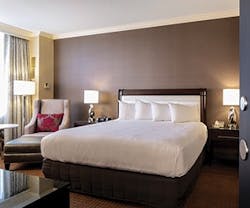How I Sourced It... Hilton Minneapolis
Interiors & Sources: Tell us a little about the project—what were the existing guestrooms like and what was your vision for the update?
Michael Maurer: One of the things that would strike you upon entering a guest room is that there were three or four different wood grains going on—everything from a faux natural oak baseboard to a dark, almost ebonized walnut on the headboard, to a medium oak on the doors. It was not done in a thoughtful way; they were just various pieces that had been installed over the course of the property's lifespan. We wanted to unify some of those tones and add a punch of warmth to the room.
IS: What kind of surfaces did you look at using?
MM: We looked at several different [surfacing] options. When you're talking about doing the guest room doors and the adjoining doors, as we did here, it can become very complicated very quickly. At times we were concerned that we might be stuck with the existing wood grain. That's when our project designer, Ron Degen, came up with the idea of using the 3Mtm DI-NOCtm Architectural Finishes, which proved to be a truly great application for this project.
IS: What kinds of benefits did the 3M DI-NOC Architectural Finishes bring to the project?
MM: We were concerned about durability because those doors get kicked around, so we got several samples [of 3M DI-NOC] and put them through their paces. We got out the keys and the pens, and we walked on it and kicked it, and left various food products on it to see if it would stain. We were impressed with the quality of the 3M DI-NOC. To put it on a guest room door, it really has to stand up, and it performed far better than we initially expected.
Working with Dale Nelson [Director of Property Operations, Hilton Minneapolis], we also had a mockup done, because there's the practical application of getting it on there. You can't just add another layer of laminate—the door will be that much thicker and it won't close properly. The 3M DI-NOC went on with virtually no thickness. We were able to put it on with the doors in place, with the hinges on, and the door was good to go.
IS: How did the finishes contribute to the Hilton's overall brand expression?
MM: They really bring a level of luxury and richness. It's a dark stain with a very consistent and fine grain, so it adds an element of luxury to the room that is very much in keeping with Hilton's desire to provide that upscale experience for their guests. We've done many Hiltons, and we always try to add an element of context there.
